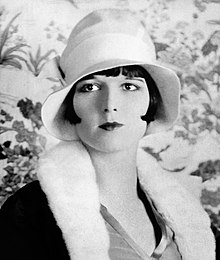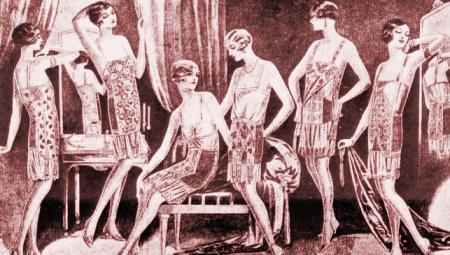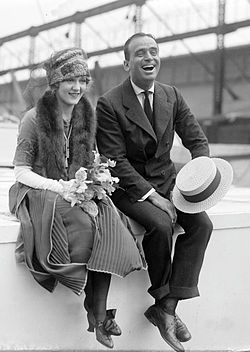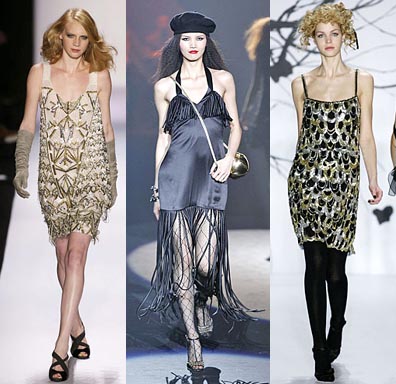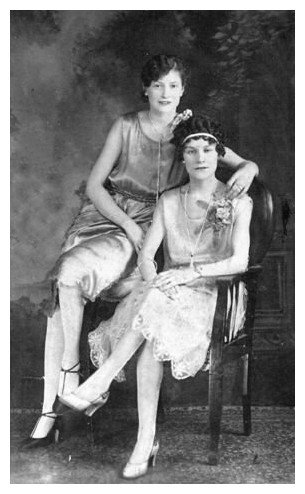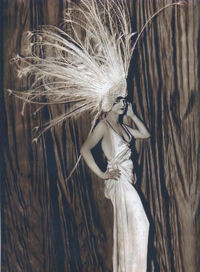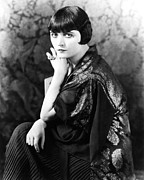1920s Fashion
The 1920s is the decade in which fashion entered the modern era. It was the decade in which women first abandoned the more restricting fashions of past years and began to wear more comfortable clothes (such as short skirts or trousers). Men also abandoned highly formal daily attire and even began to wear athletic clothing for the first time. The suits men wear today are still based, for the most part, on those worn in the late 1920s. The 1920s are characterized by two distinct periods of fashion. In the early part of the decade, change was slow, as many were reluctant to adopt new styles. From 1925, the public passionately embraced the styles associated with the Roaring Twenties. These styles continue to characterize fashion until early in 1932.
After World War I, America entered a prosperous era and, as a result of its role in the war, came out onto the world stage. Social customs and morals were relaxed in the optimism brought on by the end of the war and the booming of the stock market. Women were entering the workforce in record numbers. The nationwide prohibition on alcohol was ignored by many. There was a revolution in almost every sphere of human activity[citation needed], and fashion was no exception.In the 1920s, women’s roles radically changed and so did their fashion. As women entered the workforce and earned the right to vote, fashion trends became more accessible, masculine, and practical. Flappers were a popular name given to women of this time because of what they wore. The constrictive corset, an essential undergarment to make the waist thinner, became a thing of the past.1
The technological development of new fabrics and new closures in clothing affected fashions of the 1920s. Natural fabrics such as cotton and wool were the abundant fabrics of the decade. Silk was highly desired for its luxurious qualities, but the limited supply made it expensive. In the late 19th century, "artificial silk" was first made from a solution of cellulose in France. After being patented in the United States, the first American plant began production of this new fabric in 1910; this fiber became known as rayon. Rayon stockings became popular in the decade as a substitute for silk stockings. Rayon was also used in some undergarments. Many garments before the 1920s were fastened with buttons and lacing, however, during this decade, the development of metal hooks and eyes meant that there were easier means of fastening clothing shut. Hooks and eyes, buttons, zippers or snaps were all utilized to fasten clothing.
Vastly improved production methods enabled manufacturers to easily produce clothing affordable by working families. The average person's fashion sense became more sophisticated. Meanwhile, working-class women looked for modern forms of dress as they transitioned from rural to urban careers. Taking their cue from wealthier women, working women began wearing less expensive variations on the day suit, adopting a more modern look that seemed to suit their new, technologically focused careers as typists and telephone operators.2
The 1920s is the decade in which fashion entered the modern era. It was the decade in which women first abandoned the more restricting fashions of past years and began to wear more comfortable clothes (such as short skirts or trousers). Men also abandoned highly formal daily attire and even began to wear athletic clothing for the first time. The suits men wear today are still based, for the most part, on those worn in the late 1920s. The 1920s are characterized by two distinct periods of fashion. In the early part of the decade, change was slow, as many were reluctant to adopt new styles. From 1925, the public passionately embraced the styles associated with the Roaring Twenties. These styles continue to characterize fashion until early in 1932.
After World War I, America entered a prosperous era and, as a result of its role in the war, came out onto the world stage. Social customs and morals were relaxed in the optimism brought on by the end of the war and the booming of the stock market. Women were entering the workforce in record numbers. The nationwide prohibition on alcohol was ignored by many. There was a revolution in almost every sphere of human activity[citation needed], and fashion was no exception.In the 1920s, women’s roles radically changed and so did their fashion. As women entered the workforce and earned the right to vote, fashion trends became more accessible, masculine, and practical. Flappers were a popular name given to women of this time because of what they wore. The constrictive corset, an essential undergarment to make the waist thinner, became a thing of the past.1
The technological development of new fabrics and new closures in clothing affected fashions of the 1920s. Natural fabrics such as cotton and wool were the abundant fabrics of the decade. Silk was highly desired for its luxurious qualities, but the limited supply made it expensive. In the late 19th century, "artificial silk" was first made from a solution of cellulose in France. After being patented in the United States, the first American plant began production of this new fabric in 1910; this fiber became known as rayon. Rayon stockings became popular in the decade as a substitute for silk stockings. Rayon was also used in some undergarments. Many garments before the 1920s were fastened with buttons and lacing, however, during this decade, the development of metal hooks and eyes meant that there were easier means of fastening clothing shut. Hooks and eyes, buttons, zippers or snaps were all utilized to fasten clothing.
Vastly improved production methods enabled manufacturers to easily produce clothing affordable by working families. The average person's fashion sense became more sophisticated. Meanwhile, working-class women looked for modern forms of dress as they transitioned from rural to urban careers. Taking their cue from wealthier women, working women began wearing less expensive variations on the day suit, adopting a more modern look that seemed to suit their new, technologically focused careers as typists and telephone operators.2
1920s Fashion
1920s Fashion
1920s Fashion
1920s Fashion
1920s Fashion
1920s Fashion
1920s Fashion
1920s Fashion
1920s Fashion
1920s Fashion
1920s Fashion
1920s Fashion
1920s Fashion
1920s Fashion
1920s Fashion
1920s Fashion
1920s Fashion
1920s Fashion
1920s Fashion
1920s Fashion

